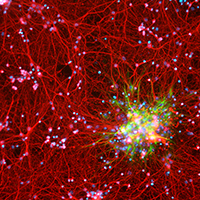Quantitative, structural and molecular changes in neuroglia of aging mammals: A review

Accepted: 27 May 2021
HTML: 11
All claims expressed in this article are solely those of the authors and do not necessarily represent those of their affiliated organizations, or those of the publisher, the editors and the reviewers. Any product that may be evaluated in this article or claim that may be made by its manufacturer is not guaranteed or endorsed by the publisher.
Authors
The neuroglia of the central and peripheral nervous systems undergo numerous changes during normal aging. Astrocytes become hypertrophic and accumulate intermediate filaments. Oligodendrocytes and Schwann cells undergo alterations that are often accompanied by degenerative changes to the myelin sheath. In microglia, proliferation in response to injury, motility of cell processes, ability to migrate to sites of neural injury, and phagocytic and autophagic capabilities are reduced. In sensory ganglia, the number and extent of gaps between perineuronal satellite cells – that leave the surfaces of sensory ganglion neurons directly exposed to basal lamina– increase significantly. The molecular profiles of neuroglia also change in old age, which, in view of the interactions between neurons and neuroglia, have negative consequences for important physiological processes in the nervous system. Since neuroglia actively participate in numerous nervous system processes, it is likely that not only neurons but also neuroglia will prove to be useful targets for interventions to prevent, reverse or slow the behavioral changes and cognitive decline that often accompany senescence.
How to Cite
PAGEPress has chosen to apply the Creative Commons Attribution NonCommercial 4.0 International License (CC BY-NC 4.0) to all manuscripts to be published.
Similar Articles
- F Cappello, M Bellafiore, A Palma, S David, V Marcianò, T Bartolotta, C Sciumè, G Modica, F Farina, G Zummo, F Bucchieri, 60KDa chaperonin (HSP60) is over-expressed during colorectal carcinogenesis , European Journal of Histochemistry: Vol. 47 No. 2 (2003)
- Maria Elisa Perotti, In memoriam of Prof. Aurelio Bairati , European Journal of Histochemistry: Vol. 62 No. 1 (2018)
- D Albani, L Giorgetti, L Pitto, M Luo, RM Cantoni, Proliferation-dependent pattern of expression of a dihydrofolate reductase-thymidylate synthase gene from Daucus carota , European Journal of Histochemistry: Vol. 49 No. 2 (2005)
- Carlo Pellicciari, Marco Biggiogera, Manuela Malatesta, A journal of histochemistry as a forum for non-histochemical scientific societies , European Journal of Histochemistry: Vol. 63 No. 4 (2019)
- M Cotrufo, L De Santo, A Della Corte, F Di Meglio, G Guerra, C Quarto, S Vitale, C Castaldo, S Montagnani, Basal lamina structural alterations in human asymmetric aneurismatic aorta , European Journal of Histochemistry: Vol. 49 No. 4 (2005)
- Tommaso Maluta, Umberto Lavagnolo, Lydia Segalla, Nicholas Elena, Paolo Bernardi, Daniele Degl'Innocenti, Andrea Sbarbati, Bruno Magnan, Evaluation of biocompatibility, osteointegration and biomechanical properties of the new Calcemex® cement: An in vivo study , European Journal of Histochemistry: Vol. 66 No. 1 (2022)
- G Stabellini, P Locci, M Calvitti, R Evangelisti, L Marinucci, M Bodo, A Caruso, S Canaider, P Carinci, Epithelial-mesenchymal interactions and lung branching morphogenesis. Role of polyamines and transforming growth factor ß1 , European Journal of Histochemistry: Vol. 45 No. 2 (2001)
- CarloAlberto Redi, Mitosis Methods & Protocols , European Journal of Histochemistry: Vol. 54 No. 2 (2010)
- CarloAlberto Redi, Calcium measurement methods , European Journal of Histochemistry: Vol. 54 No. 3 (2010)
- Dailun Hu, Philip K. Nicholls, Melissa Claus, Yongkang Wu, Zhongli Shi, Wayne K. Greene, Bin Ma, Immunofluorescence characterization of innervation and nerve-immune cell interactions in mouse lymph nodes , European Journal of Histochemistry: Vol. 63 No. 4 (2019)
<< < 76 77 78 79 80 81 82 83 84 85 > >>
You may also start an advanced similarity search for this article.

 https://doi.org/10.4081/ejh.2021.3249
https://doi.org/10.4081/ejh.2021.3249










